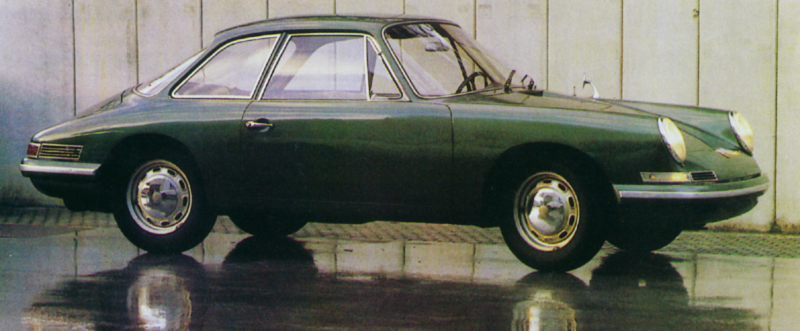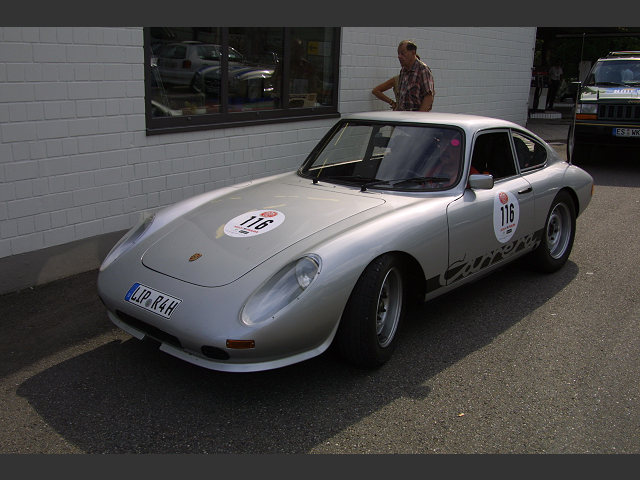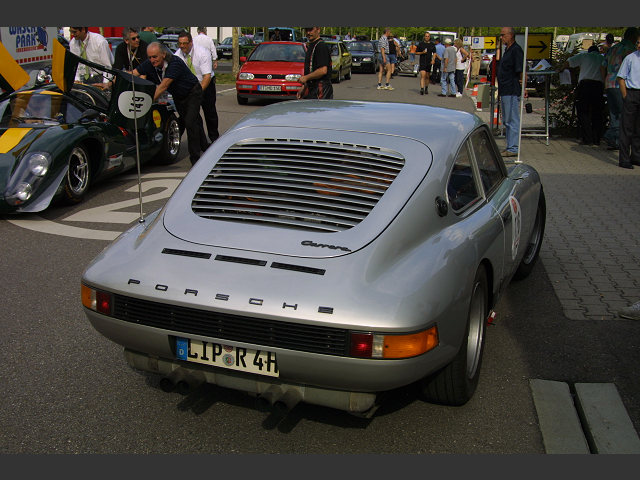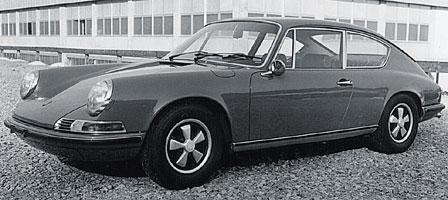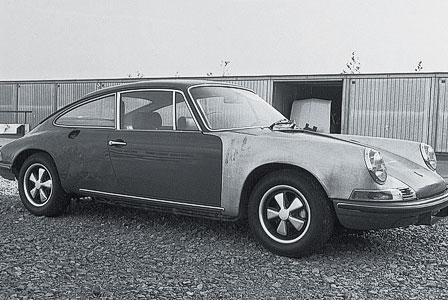Home › Forum › Porscheforum Fotoboek › Porsche algemene Foto’s › De Grote Porsche Quiz !!!
- Dit onderwerp bevat 76 reacties, 17 deelnemers, en is laatst geüpdatet op 16 jaren, 1 maand geleden door
 8ees (komt van ‘Eighties’) ;-).
8ees (komt van ‘Eighties’) ;-).
-
MakerDiscussie
-
MakerDiscussie
-
dees heb ik er van terug gevonden
porsche carrera 2 type 587 en 904gts
Acknowledging low American sales of its higher-end machines, Porsche offered only detrimmed Carrera GT coupes for 1960-61 with lightweight Reutter bodywork, simplified bumpers without guards, aluminum hubcaps, and a more Spartan interior. The 1960 models retained the 692/3 power unit. An evolution, the 692/3A model, arrived for ‘61 with larger main-bearing journals, stronger con rods, and redesigned cams with a total of six small flywheels to quell harmonic vibration in the valvetrain.
The Carrera 2’s Type 587 engine also powered real racers, like the Porsche 904.
But sales continued to be disappointing, so the final roadgoing 356 Carreras bowed at the Frankfurt Show in late 1961 for the ‘62 model year. Based on the 1960 B-Series, they included a steel-bodied 1600 coupe with a 1,582-cc engine packing 90 horsepower at 5500 rpm; a lighter 1600GS with 115 horsepower at 6,500 rpm from 1,588cc; and a new 2000GS, also known as the Carrera 2. The last featured the new four-wheel Dunlop disc brakes, and all three had the latest body modifications except the bumper-guard exhaust outlets (the tips exited below the bumper, as before, but within a protective apron).
The Carrera 2’s most prominent selling point was its Type 587 engine. An expansion of the Type 547, it was decidedly oversquare at 92 × 74 mm – 1,966cc in all. Horsepower was 130 DIN European at 6,200 rpm (150 SAE), close to 1.3 horsepower per cubic inch. The torque curve was broad and flat, and peaked at an impressive 131 pounds/feet at 4,600 rpm. Reflecting lessons learned in the marketplace, the Carrera 2 had plain bearings rather than the roller type, and its top two gears had longer-striding ratios for lazy Americans. This alteration to gearing was not a major one but gave the U.S. Carrera 2 that fraction of extra power that made the difference between lugging and strong pull off the line. For this reason, not to mention the car’s innate civility, it proved the most popular Carrera yet.
Indeed, civility was the key. Hansjoerg Bendel lauded the “notable innovation†of a combination fresh-air intake and heater fan (via an optional gasoline heater), the comfortable Reutter seats, the quick shifter, and, above all, the unmistakable quality of a car built for the connoisseur. He also approved of the chassis: “The steering gave improved response with reduced vibration, the car seemed to stick better to the road and stay stuck during hard acceleration, and the disc brakes, added late to the Carrera 2 specification, were more than adequate.â€
Acceleration, which Bendel termed “exhilarating,†was more than adequate, as well. He noted, “The clutch takes quite a bit of throttle without protest, and when one finds that it is time for 2nd gear, down comes the stick in a flick, more acceleration, and other cars pass by as if in reverse. High up in the speed range, this is it — the effortless superiority of the true high-performance machine.â€
Bendel complained that the Carrera was still too noisy — and for a hefty $7,595, it probably was. Also, the engine had a “certain roughness well remembered from older Carreras.†Finally, and perhaps telling in 1962, was the near 20-year-old basic design: “Even the accustomed eye begins to notice some signs of age. The instrument panel, for example, is higher up than is usual nowadays, and visibility could only benefit from a lower waistline.†But he should have been more patient. The 911 was on its way.
But not before a short run of 356C-based Carrera 2s in 1963. Like the ‘62s, they were available with Porsche’s usual vast assortment of competition equipment: a larger fuel tank, a limited-slip differential, and special weight-saving body and chassis components — virtually anything a would-be racer might want.
Bendel aptly summed up the Carrera 2 as “one of the most desirable GT cars†of its day, one to “delight the owner looking for a car of high quality and exceptional roadworthiness.†But like most good things, it was short-lived, built mainly to homologate the Type 587 engine for competition, initially in production-based cars and later in the factory’s more specialized racers such as the 2000GS/GT and the lovely 904.
But the ultimate 356s left their mark as the first of a grand roadgoing line that persists through the 911 Series to this day. Every indication is that that pedigree will be perpetuated well into the future.
grtz Geert 😉
0Veel info heb ik niet gevonden doch die ik heb hou ik even achter .
Ik zal een tipje van de sluier lichten .
Het is wel degelijk een Porsche en het gaat om een wagen uit 1962 😈0[quote=”911-lover”:3vkm82ud]En nog een rariteitje voor jullie .
Ik laat de uitleg over aan de kenners hier 🙄 😉En ondertussen even de titel aangepast 😆 😆 [/quote]
spiegels van een 924 ?
0Ik heb het gevoel dat het een hybrid is, gebouwd rond een crashed of ongebruikte carroserie van een Apal coupe
Let op de voorruit lijn, de vorm van de motorkap,en een verongelukte 911 (gezien de achterraampjes, de ruitenwissers, enz) en, mogelijkerwijs, een creatieve interpretation in de neus van een van de eerste 356 Carrera B Abarth GTL.
en de 904?
Anyway, Ik kijk uit naar het antwoord!
Bert
0Dit heb ik nog nooit gezien.
Ik doe een gokje. Is dat niet van Belgische makelij ?
Een Abarth ?0En nog een rariteitje voor jullie .
Ik laat de uitleg over aan de kenners hier 🙄 😉En ondertussen even de titel aangepast 😆 😆
0Er bestaat trouwens nog een 4-zitter gemaakt door Troutman and Barnes uit California. deze was gemaakt als geschenk voor de vrouw van William Dick Junior.
Basis was een 911S uit 67 met Sportomatic. De wagen was 53 cm langer, 4 deuren en 4 voorzetels, 2 vooraan en 2 achteraan. De achterste deuren gingen omgekeerd open (suicide doors)
Later is de 2 liter vervangen door een 2.7 en de Sportomatic door een gewone boite.
De toen nieuwe eigenaar Dan Burnes heeft er 4* 7*15 velgen , A/C van een Audi en een nieuwe lak gegeven.0klopt de eerste is van Pininfarina, intern B17 genoemd. Eerst in 69 verandert naar 4-zits met gewichtverdeling 39-61 en 1135 kg
In 1975 heeft men de wagen verandert naar Carrera specs met 2.7 210pk 7+8 fuchsvelgen,carrera verbreding en louvres achter het achterraampje,…0De eerste is van pininfarina, de tweede is de in-house 2+2!
😉
Bert
0was het die, die ze 901 als nr wilden geven? tot er veto van Peugeot kwam, “0” in het midden is enkel voor Peugeot toegelaten?
0
- Je moet ingelogd zijn om een antwoord op dit onderwerp te kunnen geven.

